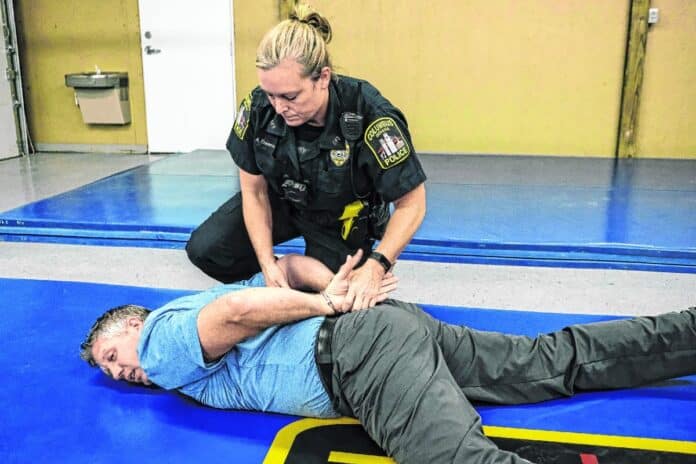
Amid the national debate on use of force by police and racial justice, local law enforcement officers say the tactics they teach their officers to use to restrain or subdue suspects are carefully followed, monitored and reviewed to avoid situations such as those that unfolded in Minneapolis involving the death of George Floyd.
The techniques, also known as “physical tactics,” used by police across the country, have come under increased scrutiny over the past couple weeks after Floyd was filmed on May 25 handcuffed and forced face-down on the pavement, a white Minneapolis Police Department officer firmly kneeling on Floyd’s neck for nearly nine minutes while Floyd told officers he couldn’t breathe and begged for help.
The video of that incident sparked protests and rallies across the country, including one in Columbus where 700 to 1,000 people gathered at Columbus City Hall plaza to support for families of black victims in a string of recent high-profile police brutality cases across the nation, and to build unity for racial equality and justice.
The tactic shown in Floyd’s death, which is allowed at some law enforcement agencies, has drawn widespread condemnation, including among local law enforcement officials. It is not permitted by the Columbus Police Department or the Bartholomew County Sheriff’s Department, officers said.
[sc:text-divider text-divider-title=”Story continues below gallery” ]Click here to purchase photos from this gallery
“(We) are specifically taught the exact opposite,” said Sgt. Tom Foust of the Columbus Police Department, who teaches defensive tactics for the department.
CPD officers and Bartholomew County sheriff’s deputies are trained on a series of techniques used to restrain people based on curriculum from the Indiana Law Enforcement Academy.
The tactics range from use of pressure points to several take downs and holds that officers can use to temporarily subdue an individual, including the placement of the knee on the shoulder blade and parts of the back to keep them from rolling over while being handcuffed.
New hires at the Columbus Police Department undergo two to three days of physical tactics training — including what is deemed a reasonable and legal use of force — and every officer receives at least eight hours of additional physical tactics training every year, Foust said.
CPD officers also receive training from Paul Whitesell, clinical services director at the Indiana Law Enforcement Academy and court-certified use-of-force expert, according to the academy’s website.
Bartholomew County sheriff deputies go through a similar set of physical tactics training, with deputies receiving an eight-hour course upon being sworn in and additional four- to eight-hour trainings every two to three months, said Capt. Dave Steinkoenig of the Bartholomew County Sheriff’s Department. Steinkoenig is a uniform division commander and defensive tactics trainer.
Sheriff’s deputies also receive training in Gracie Survival Tactics, which is a defensive tactics system tailored to law enforcement officers and military that is based on Jiu-Jitsu, according to Gracie University, a California-based academy, Steinkoenig said.
“Basically, it is Jiu-Jitsu, also known as ground fighting, for cops.” Steinkoenig said. “A lot of the (training) is low impact. …There are very limited strikes, if you will. A lot of it is control techniques and leverage and, basically, if done properly, hopefully because you have that leverage, your opponent wears out long before you do and eventually gives up. That’s the end goal.”
Officers, however, are trained to stay away from the neck and not restrict airflow and to sit prone suspects up once they are restrained or handcuffed, as they are then “in custody.”
In a tactics demonstration set up by the Columbus Police Department, Foust, who was portraying a suspect, demonstrated how the officer taking the individual into custody instructs the individual on how to move in order to get the individual upright, but still remain in the control of the officer who has handcuffed him.
At that point, when the handcuffs go on, the role of the officer moves to custody and care-taking, Foust emphasized, saying the individual is in “our” custody and officers must take care of that individual.
Police are trained to call for a medic if necessary for a suspect to be checked, or if there is concern about a suspect’s condition at the time of arrest.
“We don’t do choke holds. Chokeholds are a lethal force, so we stay away from doing those,” said CPD Chief Mike Richardson. “…We de-escalate when we can. It’s one of those things that once the suspect or the person we’re dealing with, as they escalate their force that they’re using, we (adjust) ours as well.”
Similarly, sheriff’s deputies are not taught to use choke holds, but they could be a permitted tactic “in a life-or-death situation,” Steinkoenig said.
“Somebody better be trying to kill you or take your gun and kill you before you should do that,” Steinkoenig said. “I don’t know of any instances in my time that any deputies have used a choke hold because, like I said, it’s not something that we train. We don’t teach our guys to do that.”
If force is used and an officer sees an injury or if an individual says they are having trouble breathing or are injured, they are immediately checked out by medical professionals before being taken to jail, Columbus police said.
Additionally, medics are called to the scene anytime pepper spray or tasers are used, said Officer Angie Owens, a defensive tactics instructor at the Columbus Police Department.
“Anytime that anyone feels like they might need a medic, one is called for them,” she said.
Review process
Both law enforcement agencies require all instances of use of force by officers to be reviewed.
At CPD, that review process starts with a street-level supervisor who must be notified and called to the scene to evaluate what happened and if it is in line with department policy and state law, Foust said.
The supervisor will then file a use-of-force report that is reviewed by Foust or another supervisor, who examines the case report, body cameras, in-car cameras, witness statements and other documentation “to ensure the use of force falls within policies, procedures and the law.”
At least two supervisors review all use of force by CPD officers, and each instance is documented in a computer system called Guardian, which allows all supervisors above that officer to view the report and other documentation, Richardson said.
Guardian also functions as an “early-warning system,” alerting supervisors if an officer is involved in three incidents of use of force, pursuits or receives complaints, prompting an internal review, Richardson said.
The Bartholomew County Sheriff’s Department, for its part, has a similar review process for each time a deputy uses any type of force, Steinkoenig said.
If force is used, the deputy has to fill out a use-of-force report that is reviewed by their supervisor, a tactical instructor and another supervisor, which typically is Steinkoenig.
“Typically, once I sign off on that, those all go to Maj. Chris Lane, the chief deputy,” he said.
Any violations of department policy or state law would prompt an internal investigation, Steinkoenig said.
Officials at both law enforcement agencies said officers found to have violated policy or state law could face punishments ranging from a written reprimand to suspension or termination depending on the circumstances.
However, use of force is not common at either law enforcement agency, with less than 1% of interactions with the public resulting in officers using force, according to local statistics.
A total of 129 of 91,059 calls for service involving CPD officers resulted in the use of force in 2018 and 2019, according to figures provided by CPD. Bartholomew County sheriff’s deputies reported using force 28 times out of 80,622 calls for service over the same time period.
Over roughly the first half of this year, CPD officers reported using force 22 times, while Bartholomew County sheriff’s deputies reported four instances.
Steinkoenig said the sheriff’s department has not received any complaints involving the use of force over the past five years.
Harris said there have been no “substantiated” use-of-force complaints against CPD officers in the past five years.
What is reasonable force?
The key question, according to legal precedent, is would a reasonable officer with a similar background and experience have responded the same way?
In the past, many law enforcement agencies across the country used what is called a “use-of-force continuum,” which is a series of guidelines that set out precisely what kinds of physical tactics an officer can used based on the level of force used by the suspect.
Essentially, the continuum would state “if the suspect or person we’re dealing with did A, the officer could do B” and that officers would be justified in going one level above the level of force used by the suspect.
However, several agencies, including CPD, have shifted away from continuums toward what they call the “legal threshold of reasonableness,” Harris said.
The threshold is based on a 1989 U.S. Supreme Court case that has shaped the national legal standards that govern when police officers are justified in using force, according to the The Associated Press.
The case, Graham v. Connor, involved Dethorne Graham, a diabetic who was experiencing a blood-sugar episode in North Carolina in 1984 and asked a friend to drop him off at a store so he could get orange juice, according to wire reports.
When Graham saw the long line, he left behind the juice, ran out of the store and rode away in a car. An officer, M.S. Connor, saw Graham leave, became suspicious and pulled him over to investigate.
Backup officers arrived and handcuffed Graham, ignoring his pleas that he was having a diabetic reaction. During the encounter he suffered multiple injuries, but was released after the initial officer determined nothing illegal had happened.
The Graham decision found that an officer’s use of force should be considered on the facts of each case. Officers are to weigh the seriousness of the crime, whether the suspect poses a threat to the safety of police or others and whether the suspect is trying to resist arrest.
“The ‘reasonableness’ of a particular use of force must be judged from the perspective of a reasonable officer on the scene, rather than with the 20/20 vision of hindsight,” Chief Justice William Rehnquist wrote in the decision.
In Graham’s case, his behavior as he was experiencing low blood sugar looked similar to that of a belligerent drunk, according to wire reports.
Since the 1989 decision, courts in most instances have sided with the police in cases involving allegations of excessive force, according to the The Associated Press.
Officials from the Columbus Police Department and Bartholomew County Sheriff’s Department, however, emphasized officers attempt to deescalate situations when possible and use the least amount of force possible.
In the demonstrations by Columbus police and sheriff deputies, the officers emphasized that even when approaching a scene, awareness of where each officer is in relation to other individuals around, situation awareness, is part of the training.
Officers are also cognizant of where their hands and knees are placed on a suspect and are trained on where nerve motor and pressure points are that could be dangerous if impacted by tactics, officers demonstrating the tactics said.
Foust also pointed out that many of the tactics begin with a “disrupt” move, which helps interrupt the thought processes of the suspect and is likely to result in the individual being caught off-guard and being taken into handcuffs more quickly.
“A big thing, it just comes down to knowing how to talk to people, trying to communicate without escalate the situation further, whether that be body language, tone of voice and just knowing how to communicate with people,” Harris said. “That is something that our training officers work with a lot with new recruits is just getting them comfortable with talking to people.”
“Not every situation is going to end the way that our officers want it to, and if a person cannot be reasoned with, our officers are going to take the necessary actions to get them into custody, but as our use-of-force numbers reflect, that’s not very often,” Harris added.




